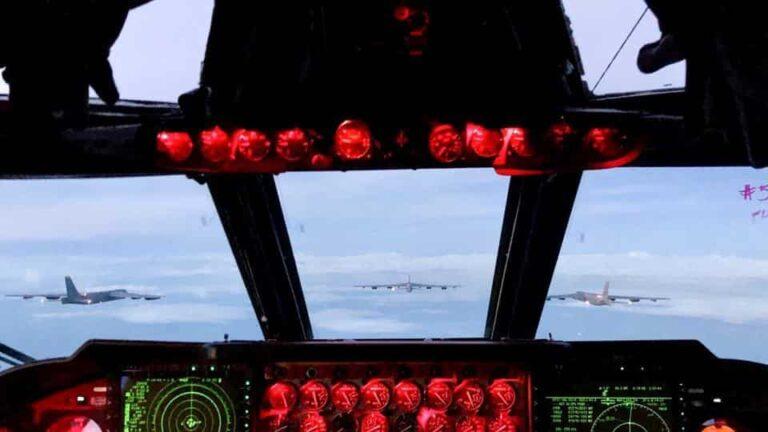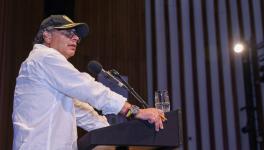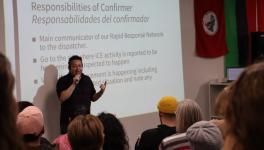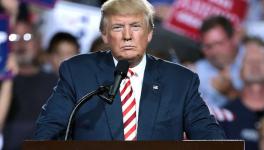US-Russia Tensions Flare up on Multiple Fronts

Russian Su-27 Flanker jets crossing within 100 feet of the nose of a nuclear-capable US B-52 bomber in Black Sea, August 28, 2020
Amidst the escalating tensions with China, the United States should have kept the troubled relationship with Russia on an even keel. But the opposite is happening. For the first time since the presidential election in Belarus on August 9, Washington has openly sided with the protests in Minsk and dared Russia to intervene.
Berlin has simultaneously announced that the Russian opposition leader Alexei Navalny was poisoned by Novichok nerve agent. Curiously, Germans went public with the explosive information without even notifying Moscow first. Presumably, the US was in the loop, given Navalny’s standing in Russian politics.
Most certainly, Washington and Berlin have moved in tandem over Belarus and Navalny respectively. A major confrontation is brewing. The warning over Belarus came at the level of the US Deputy Secretary of State Stephen Biegun who conveyed a harsh message to the Kremlin via the cold war era megaphone Radio Liberty:
“The last four years has been very challenging for U.S.-Russian relations, but it is possible that it could be worse. And one of the things that would limit the ability of any president, regardless of the outcome of [the U.S. presidential election in November], in developing a more cooperative relationship with Russia, in any sphere, would be direct Russian intervention in Belarus.”
Within hours, Secretary of State Mike Pompeo stepped in “demanding an immediate end” to the Belarus government’s moves to curb the protests and warning of “significant targeted sanctions” in consultation with Washington’s transatlantic partners.
This is a direct challenge to President Vladimir Putin who had stated last week that Russia is obliged to intervene in Belarus under the Russia-Belarus Unity Pact of 1998 and the Collective Security Treaty. (See my blog Anatomy of coup attempt in Belarus, August 30, 2020)
The US intention is to put Russia on the dock with the simultaneous diplomatic offensives on two fronts. The Russian ambassador to Germany was summoned to the foreign ministry in Berlin a few hours ago; meanwhile, the protests in Minsk are enjoying a fresh lease of life.
The Russian Foreign Minister Sergey Lavrov today condemned the “attempts made by several foreign states” to fuel the protests in Minsk and noted “a rise in NATO activity near Belarusian borders.” The Russian and Belarusian intelligence agencies are in touch.
The Belarus foreign minister Vladimir Makei visited Moscow today for talks with Lavrov. The chiefs of the General Staffs of Russia and Belarus discussed on the phone today “the state and the prospects of bilateral military cooperation and also the pace of preparations for the Slavic Brotherhood joint drills.” A visit by Belarus President Alexander Lukashenka to Moscow is expected shortly.
While the Navalny affair is more of the stuff of propaganda to smear Russia’s reputation in the western opinion, Moscow will focus on the Belarus situation. Putin underscored last week that amongst the former Soviet republics, Belarus “perhaps is the closest, both in terms of ethnic proximity, the language, the culture, the spiritual as well as other aspects. We have dozens or probably hundreds of thousands, if not millions, of direct family ties with Belarus and close industrial cooperation.”
Lavrov didn’t mince words when he hit back today, “Moscow will provide an adequate and firm response based on facts to those who are trying to derail the situation in Belarus…(and) to turn the republic away from Russia and undermine the foundations of the Union State.”
What is Washington’s game plan? Indeed, it suits President Trump’s campaign if his administration is seen as hanging tough on Russia. In substantive terms, Washington probably chose to go on the offensive considering that Russian intelligence has zeroed in on the CIA blueprint to stage a colour revolution in Belarus.
In fact, there has been a dizzying array of standoffs involving Russia in the most recent days. The US and Russian military clashed six days ago when a vehicle forming part of a Russian convoy in north-eastern Syria rammed an American armoured vehicle injuring 4 US soldiers, prompting Biden to taunt Trump, “Did you hear the president say a single word? Did he lift one finger? Never before has an American president played such a subservient role to a Russian leader.”
On August 31, the US military announced that over the next 10 days it will be conducting live-fire exercises just 70 miles from Russian border. On August 28, the US flew six nuclear-capable B-52 bombers over 30 NATO countries in a major show of force. Two of them flew over the Black Sea and were intercepted by two Russian fighter jets, which crossed within 100 feet of the nose of one of the bombers, reportedly disrupting its ability to maintain its bearing.
On August 27, the Russian guided missile submarine Omsk surfaced off the coast of Alaska and participated in live-fire exercises in the Bering Sea. Also on August 27, NORAD sent two F-22 jets to intercept three groups of Russian military maritime patrol aircraft off the Alaskan coast.
With growing signs of Russia digging in, the Plan B over Belarus is surfacing. Both Belarus and Navalny are noble causes that come handy for Washington to rally Europe and re-establish its transatlantic leadership, which has been in tatters lately with the EU, France, Germany and UK joining Russia and China to block the Trump administration’s attempt to impose “snapback” sanctions against Iran.
Above all, Washington feels frustrated that its clumsy attempts to create daylight between Russia and China have floundered. China has voiced support for Lukashenka; the Sino-Russian juggernaut is puncturing holes from all sides in Trump’s maximum pressure strategy against Iran,
In a feature article entitled China, Russia Deepen Their Ties Amid Pandemic, Conflict with the West, Radio Liberty recently listed several new Russia-China economic projects in the pipeline to boost the relations further.
These include one of the world’s largest polymer plants that Russia is building in Amur, near the Chinese border costing $11 billion in collaboration with China’s giant Sinopec Group; commencement of natural gas supply to China through the 2,900-kilometer Power Of Siberia pipeline; plan to start work on a second pipeline, Power Of Siberia 2; plans to more than triple Russian gas deliveries to China; new scientific cooperation testing vaccines for COVID-19; concerted “de-dollarisation” plan aimed at limiting the use of dollar in bilateral transactions and so on.
Get the latest reports & analysis with people's perspective on Protests, movements & deep analytical videos, discussions of the current affairs in your Telegram app. Subscribe to NewsClick's Telegram channel & get Real-Time updates on stories, as they get published on our website.





















